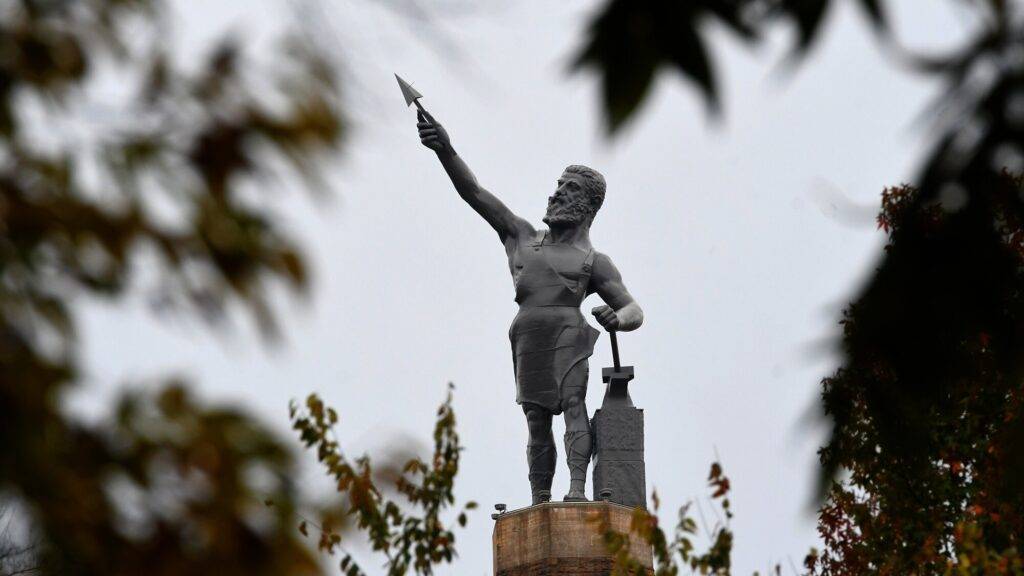
In the bustling city of Birmingham, Alabama, the Vulcan Statue stands tall as a symbol of the city’s rich industrial heritage and its spirit of progress. Overlooking the city from Red Mountain, this colossal iron figure is not only a testament to Birmingham’s history but also a beacon of its bright future. In this article, we’ll delve into the origins, significance, and enduring legacy of the Vulcan Statue.
Key Details
- Location: Vulcan Park, 1701 Valley View Dr, Birmingham, AL 35209
- Designed by: Italian sculptor Giuseppe Moretti
- Debut: 1904 World’s Fair in St. Louis
- Height: 56 feet tall
- Weight: 100,000 pounds
- Material: Cast iron (largest cast-iron statue in the world)
- Symbolism: Represents the Roman god of fire and forge, Vulcan
- Original Purpose: Showcase Birmingham’s iron and steel industry
- Current Location: Atop Red Mountain, overlooking Birmingham
- Restorations: Underwent significant restoration in the early 2000s
- Features: Observation Balcony offering panoramic views of Birmingham
- Nearby Attractions: Vulcan Park Museum, Five Points South district, Birmingham Civil Rights Institute
- Awards: Won the grand prize at the 1904 World’s Fair
- Pedestal Height: 124 feet
- Significance: Symbol of Birmingham’s industrial heritage and progress.
Where Is The Vulcan Statue?
Address: 1701 Valley View Dr, Birmingham, AL 35209
The History of The Vulcan Statue
The Vulcan Statue has its roots in the early 20th century when Birmingham sought to showcase its burgeoning iron and steel industry at the 1904 World’s Fair in St. Louis. Designed by Italian sculptor Giuseppe Moretti, the statue was intended to represent the Roman god of fire and forge, Vulcan, highlighting the city’s prowess in metalwork and its abundant natural resources.
Upon its debut at the World’s Fair, the Vulcan Statue garnered widespread acclaim, winning the exposition’s grand prize. Its impressive stature, standing at 56 feet tall and weighing 100,000 pounds, made it the largest cast-iron statue in the world, a title it still holds today.
Architectural and Artistic Significance
Moretti’s design for the Vulcan Statue was both innovative and deeply symbolic. The figure holds a spear in one hand, representing the products of Birmingham’s iron industry, while the other hand rests on an anvil, symbolizing the city’s hardworking spirit. The statue’s stoic expression and muscular form capture the essence of the Roman god, while its detailed craftsmanship showcases Moretti’s artistic genius.
The choice of cast iron as the primary material was deliberate, reflecting Birmingham’s status as a leading producer of iron. The statue’s pedestal, made of local sandstone, further emphasizes the city’s connection to its natural resources.
Restorations and Relocations
Over the years, the Vulcan Statue has undergone several relocations and restorations. After the World’s Fair, it was returned to Birmingham and initially placed at the Alabama State Fairgrounds. However, in the 1930s, it was moved to its current location atop Red Mountain, where it became a central feature of Vulcan Park.
The statue underwent significant restoration in the early 2000s to address structural issues and restore its original luster. Today, it stands proudly atop a 124-foot pedestal, offering panoramic views of Birmingham and serving as a reminder of the city’s storied past.
Things To Do Near The Vulcan Statue
The Vulcan Statue’s prominent position in Vulcan Park makes it an iconic landmark in Birmingham. The park itself is a hub of activity and learning, with the Vulcan Park Museum shedding light on the city’s rich industrial past and the intricate details of the statue’s design and significance. For those looking to capture the essence of Birmingham, the Observation Balcony is a treat. Accessible by elevator, it offers unparalleled views of the sprawling city below, making it a hotspot for photographers and sightseers alike.
Historical Landmarks
Just a short drive from the park, Birmingham’s historical landmarks beckon. The Birmingham Civil Rights Institute at 520 16th St N stands as a testament to the city’s pivotal role in the Civil Rights Movement. Another notable site is the 16th Street Baptist Church at 1530 6th Ave N, a symbol of the struggle for equality and the site of a tragic bombing in 1963.
Dining Options
For food enthusiasts, the nearby Five Points South district is a culinary haven. Ocean at 1218 20th St S is a favorite for seafood aficionados, boasting a menu of fresh catches and innovative dishes. Chez Fonfon at 2007 11th Ave S transports diners to France with its authentic dishes and cozy ambiance. For a more casual dining experience, Black Market Bar & Grill at 2011 Highland Ave offers a diverse menu in a vibrant setting.
Arts and Culture
Culture vultures can head to the Alabama Theatre at 1817 3rd Ave N, one of the city’s oldest movie palaces, which now hosts a variety of events, from film screenings to concerts. The Birmingham Museum of Art at 2000 Rev Abraham Woods Jr Blvd is also nearby, showcasing an impressive collection of art spanning various cultures and time periods.
With its mix of history, culture, and gastronomy, the area surrounding the Vulcan Statue offers a comprehensive experience of what makes Birmingham so special.
Conclusion
The Vulcan Statue is more than just a piece of art; it’s a symbol of Birmingham’s resilience, innovation, and progress. As the city continues to evolve and grow, the statue remains a constant reminder of its roots and the indomitable spirit of its people. Whether you’re a history buff, an art enthusiast, or simply someone looking to explore the best of Birmingham, the Vulcan Statue is a destination that promises a rich and rewarding experience.

